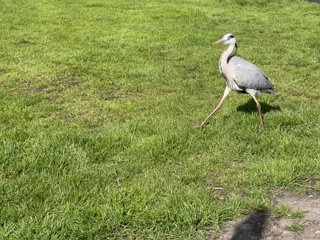MORE ABOUT HERONS
A HERON CAME BEGGING [FAIRVIEW PARK 20 APRIL 2024]
Today when I was out photographing in Fairview Park, a heron landed beside me and seemed to want to be fed. When it realised I had no food, it moved on to where a group of pigeons were being fed by an old lady.
Unsure if this was normal behaviour for this type of bird, I decided to investigate and got the following answer:
Understanding Heron Behaviour
While it's not the most typical behaviour, it's not entirely unheard of for herons to display this kind of boldness around humans. Here's why:
- Adaptability: Herons are intelligent and adaptable birds. They've learned that humans often mean food, especially in urban or park settings.
- Opportunism: Herons are opportunistic feeders. If they see a potential food source, they'll often investigate, even if it means approaching humans.
- Individual Personality: Some herons might be naturally bolder than others, leading to more frequent interactions with humans.
- Habituation: In areas where people regularly feed birds, herons can become habituated to human presence and associate humans with food.
Is it a cause for concern?
Generally, no. While it's best not to encourage the behaviour by feeding them directly, a heron approaching you is unlikely to be dangerous.
What you can do:
- Don't feed the heron: This reinforces the behaviour and can lead to dependency on humans for food.
- Enjoy from a distance: Admire the heron's beauty from afar, but don't approach it or try to interact.
- Educate others: If you see people feeding the heron, kindly inform them that it's harmful to the bird's natural foraging instincts.
Identifying the Grey Heron
- Size: Grey Herons are large birds, standing about 90-100 cm tall with a wingspan of 1.7 - 1.9 metres.
- Colouration: Predominantly grey plumage with a long, white neck and head. They have a black stripe above their eye and a striking yellow dagger-like bill.
- Silhouette: In flight, Grey Herons have a distinctive hunched posture, with their neck tucked in an 'S' shape, and their long legs trailing behind.
- Habitat: Found near wetlands, rivers, lakes, and coastal areas across Ireland. They often stand motionless at the water's edge, hunting for fish.
Birds You Might Confuse It With:
- Little Egret: Little Egrets are smaller and entirely white. They also have a black bill and dark legs, along with bright yellow feet.
- Crane: Cranes are also large birds, but they have a much longer neck held straight in flight. Their plumage also tends to be more uniformly grey. Cranes are less common in Ireland than Herons.
Key Distinguishing Features
Focus on these aspects to tell a Grey Heron apart from other similar birds:
- Grey body and white neck: The classic contrasting colors of the Grey Heron.
- Yellow bill: This large, pointed bill is a very distinctive feature.
- S-shaped neck in flight: The tucked neck of the Grey Heron makes them easily identifiable when they take to the air.
Additional Notes:
- Grey Herons have a loud, harsh "fraaank" call.
- They often nest in colonies called heronries, high up in trees.

MORE ABOUT HERONS